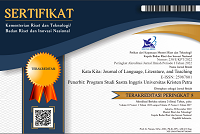PERCY JACKSON’S JOURNEY TO FIND HIS IDENTITY
DOI:
https://doi.org/10.9744/katakita.3.4.27-32Keywords:
Internal, Eksternal, SWOT, Strategi Bersaing.Abstract
Percy Jackson: The Lightning Thief and Percy Jackson: Sea of Monsters are two films that are taken from Rick Riordan’s famous Percy Jackson Series. Percy Jackson series is talking about a sixteen-year-old boy who does not know that he is a demigod and faces problem as a human being. Because he does not know that he is a demigod and faces problem as a human being, he conduct a journey to search his identity. In his journey to search his identity, Percy who has a certain disability as a teenager, can become a hero and save the gods’ world. In this paper, I will reveal the way Percy Jackson finds his identity by taking a journey and makes him become a hero in the world of the gods. I will combine the theory of Joseph Campbell, the hero’s journey, and the theory of Erik Erikson, the identity crisis, to analyze Percy Jackson’s journey to search for his identity. Besides Percy finds his identity in the journey, he also finds himself as a heroReferences
Boeree, C. G. (1997). Personality Theories: Erik Erikson. Retrieved from http://webspace.ship.edu/cgboer/erikson.html
Campbell, J. (2004). The hero with a thousand faces. Retrieved from http://www.yourskypeschool.com/book_yss_eng/Campbell_Joseph-The_Hero_With_A_Thousand_Faces.pdf
Erikson, E. H. (1968). Identity: Youth and Crisis. New York: W. W. Norton & Company, Inc.
Mc.Leod, S. (2008). Erik Erikson. Retrieved March, 2015 from http://www.simplypsychology.org/Erik-Erikson.html
Downloads
Issue
Section
License
Authors who publish with this journal agree to the following terms:- Authors retain copyright and grant the journal right of first publication with the work simultaneously licensed under a Creative Commons Attribution License that allows others to share the work with an acknowledgement of the work's authorship and initial publication in this journal.
- Authors are able to enter into separate, additional contractual arrangements for the non-exclusive distribution of the journal's published version of the work (e.g., post it to an institutional repository or publish it in a book), with an acknowledgement of its initial publication in this journal.
- Authors are permitted and encouraged to post their work online (e.g., in institutional repositories or on their website) prior to and during the submission process, as it can lead to productive exchanges, as well as earlier and greater citation of published work (See The Effect of Open Access).














